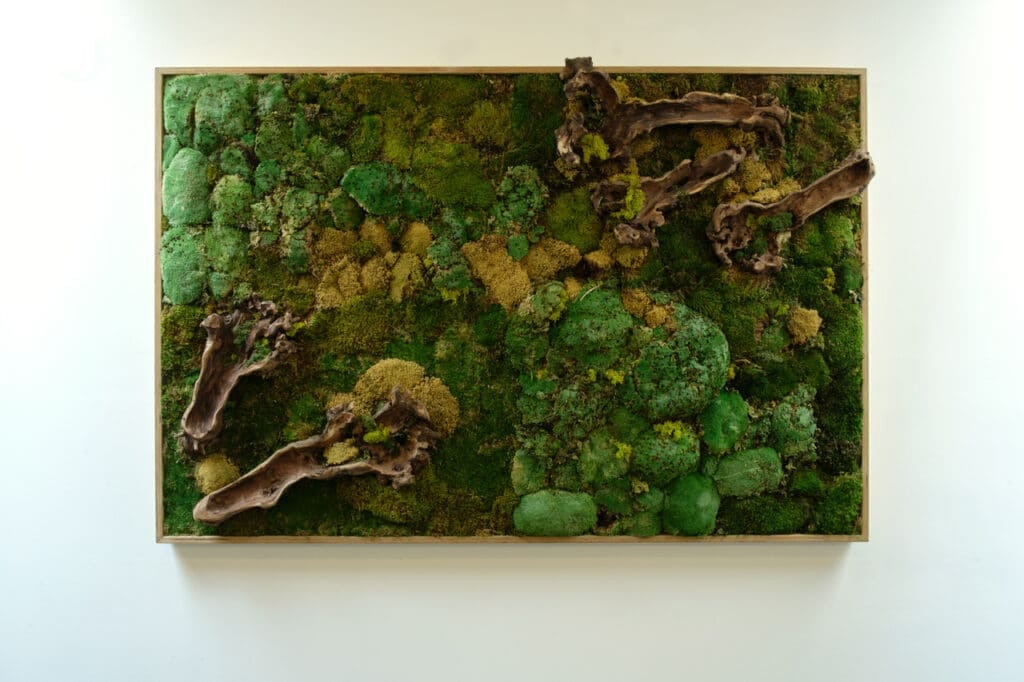In modern office design, a moss wall can serve as more than a decorative feature. It becomes a natural art piece that transforms the atmosphere of any workspace. Combining multiple moss textures creates movement, dimension, and depth, giving walls a refined and dynamic appearance.
When designed thoughtfully, moss walls go beyond their visual appeal. They reflect your brand’s identity, promote well-being, and demonstrate attention to detail. This guide explores how to use mixed moss textures effectively to design a space that’s both striking and cohesive.
Understanding Texture and Depth in Moss Wall Design
Texture is what gives a moss wall its life and vibrancy. By layering various moss types, you can build a design that feels organic and fluid rather than flat or monotonous. Three common moss textures that work well together are:
- Sheet moss: Provides a smooth and calming green base for large areas.
- Reindeer moss: Offers bold color and structure, perfect for accents or brand highlights.
- Cushion moss: Adds soft mounds that play beautifully with lighting and shadows.
A successful moss wall uses these textures in balance. For example, reindeer moss can emphasize company colors, while cushion moss highlights focal areas such as around a logo. When carefully composed, this layering creates a sense of rhythm and natural variation, making the wall feel alive and engaging.
Aligning Plant Installation With Your Brand Palette
Your moss wall should blend seamlessly with your brand’s visual identity. Instead of being a standalone feature, it should enhance your existing environment. Aligning your plant installation with your brand palette ensures a cohesive and professional result.
Practical ways to achieve brand alignment include:
- Matching accent moss to key brand colors using reindeer or preserved moss varieties.
- Choosing frames or planters that complement your office materials, such as wood, stone, or metal.
- Selecting a layout that mirrors your brand personality: symmetrical for a modern aesthetic, or organic for a more natural tone.
- Coordinating lighting color temperature to emphasize your moss tones without altering their hue.
- Creating modular panels that can be refreshed or updated as your brand evolves.
Every design decision should serve a visual purpose. To maintain the wall’s freshness and color integrity, consider reading this detailed guide on moss wall maintenance.
Choosing the Right Materials and Maintenance Strategy
The quality of your moss materials and how you maintain them directly influence the wall’s appearance over time. Not all moss types are suited for every interior environment, so careful selection ensures both beauty and durability.
Follow these recommendations for the best results:
- Use preserved moss for low-maintenance environments where watering isn’t ideal.
- Choose living moss only when humidity and light conditions can be properly managed.
- Frame your wall with moisture-resistant materials such as sealed wood or aluminum.
- Incorporate lighting strategically to highlight texture variations and create depth.
- Schedule maintenance visits for color touch-ups and general refreshes to keep the wall vibrant.
Balancing design with practicality ensures your moss wall stays stunning year-round. For a deeper look at how plant art supports professional spaces, explore this article on branding through moss art.
Installation and Placement Considerations
Where and how you install your moss wall affects both its impact and longevity. Placement determines visibility, light exposure, and accessibility for maintenance. Before installation, evaluate these factors carefully:
- Lighting: Avoid direct sunlight to prevent fading. Opt for soft, even lighting or directional spotlights.
- Environment: The surface must be dry and stable to avoid moss damage or mold.
- Accessibility: Ensure panels can be easily removed for cleaning or repair.
- Traffic flow: Position the wall where it naturally catches attention, such as near entrances or meeting areas.
- Acoustic benefits: Use moss walls in echo-prone rooms to reduce noise and improve acoustics.
Thoughtful installation planning helps maximize both the functional and aesthetic potential of your design.
Why Professional Plant Design Matters
Although DIY installations may appear straightforward, moss wall design is an intricate process that requires expertise. Professional designers understand how to balance color, texture, and structure for long-lasting results.
Benefits of professional plant design include:
- Tailored consultation to match your space and brand image.
- Proper installation methods that prevent damage to walls and moss materials.
- Integration of lighting, layout, and maintenance from the start.
- Long-term durability through professional-grade materials and installation practices.
- A consistent, high-quality appearance that aligns with your overall interior design.
Investing in a professional ensures your moss wall not only looks exceptional on day one but continues to elevate your environment for years to come.
Elevate Your Brand With Natural Design
A mixed-texture moss wall captures attention, enriches indoor air, and communicates care for both people and aesthetics. By blending textures, balancing light, and aligning with your brand palette, you can transform plain walls into artistic, natural centerpieces.
To bring this visual impact into your workspace, contact The Wright Gardner for tailored moss wall installations designed to complement your brand beautifully.

